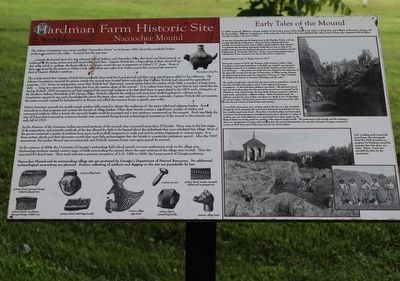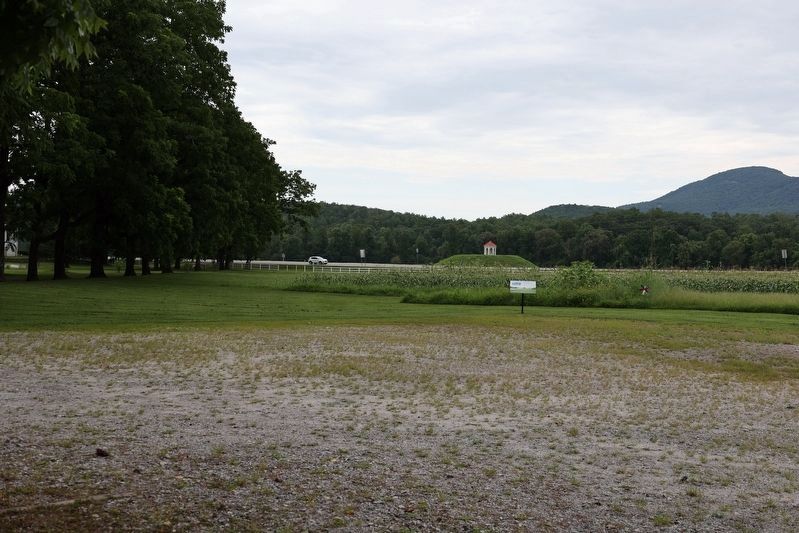Sautee Nacoochee in White County, Georgia — The American South (South Atlantic)
Nacoochee Mound
Hardman Farm Historic Site
...certainly, the favored resort of a very advanced tribe of Indians, and Nacoochee Valley, their home and burial ground, as evidenced by the many curious and well-carved relics found here. Captain Nichols has a large cabinet of them, found all over this valley which is, perhaps, the finest collection in Georgia, except the one in possession of Colonel C.C. Jones. Some of them were found by the miners on Dukes Creek, while others were taken from Indian graves that surrounded the mound in front of Captain Nichol's residence.
The article stated that Captain Nichols had accidentally discovered the burial ground and that every opened grave added to his collection. The Atlanta Constitution reported the graves outside the mound were located below rock piles that Captain Nichols had removed for agricultural purposes. C.C. Jones, an antiquarian, wrote that Nichols had "discovered, several inches below the surface of the field, a number of large stone slabs....lying at a remove of about thirty feet from the western slope of the mound." It is evident from Jones' report that he had visited the site during Nichols' 1870 excavations and had examined the recovered artifacts as he described them in great detail in his 1873 work, Antiquities of the Southern Indians Particularly of the Georgia Tribes. Nichols collected the artifacts and must have studied prehistoric cultures as the Constitution reports he was quite knowledgeable about the items, their uses, and the origins of exotic materials. Captain Nichols did not excavate the entire mound; instead, he had planted it in flowers and added the summer house or gazebo seen today.
Native American mounds are mostly simple earthen hills created to elevate the residence of the area's tribal and religious leaders. Some mounds serve dual purposes and contain the burials of village leaders. Often these burials contain a significant number of artistic and ceremonial artifacts. After a burial, the mound's height would be increased and a new residence constructed on the summit. Such was likely the case of Nacoochee's mound as numerous burials were uncovered during formal archaeological excavations of the mound in the summer and early fall of 1915.
As the Museum of the American Indian excavated portions of the mound, they uncovered more than 75 burials. Many were in the last stages of decomposition, and the scientific method of the day allowed for little to be learned about the individuals that once inhabited this village. Most of the graves contained a variety of artifacts from stone tools to shell ornaments to seeds and nuts to pottery fragments to ceramic pipes. It is these pottery sherds and their decorative motifs that most help archaeologists date the burials to a particular prehistoric period. After the 1915 excavations, Nacoochee Mound was reconstructed, and Nichols' summer house once again graced its summit.
In the summer of 2004, the University of Georgia's archaeology field school carried out some preliminary work on the village area. Archaeology students created contour maps of fields surrounding the mound where the main section of the village was located. They also excavated 83 shovel tests. Their work indicates a primary occupation of A.D. 1350 to 1600, the Lamar period of Georgia prehistory.
Nacoochee Mound and its surrounding village site are protected by Georgia's Department of Natural Resources. No additional archaeological excavations are planned. Surface collecting of artifacts and digging on the site are punishable by law.
Early Tales of the Mound
In 1896, George W. Williams, a former resident of a Nacoochee, wrote of this mound in his Advice to Young Men, and a Sketch of Nacoochee, Georgia, and Its Surroundings. Williams recorded some of the early tales of the Indians that once inhabited this valley. Some of these tales originated with his father who first traveled to the area in 1823.
At one time Nacoochee was the largest town in the Cherokee Nation, and was strongly defended by fortifications. Along the lines of these fortifications mounds were raised on which Indian chiefs securely resided in their wigwams. It is believed that the daring Spaniards visited this country as early as the twelfth century in search of gold and diamonds, and were permitted to erect the fortifications of "Nacoochee Old Town." (Note: Current archaeological research indicates that Native Americans from this era did not live in wigwams.)
Archaeologist George H. Pepper wrote in 1917:
During the summer of 1915, the Museum of the American Indian, Heye Foundation, had several expeditions in the field, one of which was engaged in archeological research in the southern part of North Carolina and the northern part of Georgia...the greater part of the time was devoted to the exploration of the Nacoochee mound near the town of Nacoochee, in White county Georgia, the field operations being under the supervision of George G. Heye, Frederick W. Hodge of the Bureau of American Indian Ethnology and the writer.
The results of exploration showed that the upper stratum extended to a depth of about five below the surface, and in it were objects of European manufacture. In this level, eleven skeletons were found. The specimens found with and about them show that this part of the mound was constructed by the Cherokee in early colonial times: the lower levels, however, seemed to indicate a much earlier and perhaps a different culture. Below the five-foot level, 64 skeletons were found; some of them were lying at a depth of over 19 feet below the mound surface. Several stone graves were uncovered and many of the other burials showed evidence of bark lining and coverings.
In one of the stone graves was a pottery vessel in the form of a dog. Scattered through the earth composing the mound were thousands of potsherds, but very few complete vessels were found. More than a hundred pottery and stone pipes and several hundred fragments of implements were found. Resting on a piece of matting near one of the skeletons in an open burial was a large copper ax, the blade of which was firmly seated in a portion of the original wooden handle. The preservation of the handle and the matting is due to the impregnation of copper salts resulting from the partial decomposition of a very thin ornament of copper, a preserved portion of which shows part of the torso and arm of a human figure.
(captions)
pottery sherd, stamped design, folded scalloped rim
pottery sherd, curvilinear stamped design folded rim
ceramic effigy head
Pottery sherd with ledge handle
Ceramic effigy pipe bowl
Ceramic ear pin
pottery sherd, incised lug handle
ceramic effigy head
pottery sherd, simply stamped folded and impressed rim
Left: Looking south toward the main house, this photograph shows the 1915 excavation in progress. Dr. Hardman owned the property when this photo was taken. Below: Local men provided the labor for the excavations.
Erected by Georgia State Parks & Historic Sites.
Topics. This historical marker is listed in these topic lists: Anthropology & Archaeology • Cemeteries & Burial Sites • Native Americans. A significant historical date for this entry is January 4, 1891.
Location. 34° 41.087′ N, 83° 42.525′ W. Marker is in Sautee Nacoochee, Georgia, in White County. Marker can be reached from Hardman Farm Road, one mile north of Unicoi Turnpike (Georgia Route 17). Touch for map. Marker is at or near this postal address: 143 GA-17, Sautee Nacoochee GA 30571, United States of America. Touch for directions.
Other nearby markers. At least 8 other markers are within walking distance of this marker. Nacoochee Indian Mound (within shouting distance of this marker); The Residence at West End (within shouting distance of this marker); Fountain and Greenhouse (within shouting distance of this marker); Breezeway,Smokehouse/Servant's Quarters & Kitchen (within shouting distance of this marker); The Game Room (about 300 feet away, measured in a direct line); Spring and Gas House (about 300 feet away); The Unicoi Road (about 400 feet away); The Carriage House (about 500 feet away). Touch for a list and map of all markers in Sautee Nacoochee.
Also see . . .
1. Hardman Farm State Historic Site. Georgia State Parks & Historic Sites (Submitted on July 25, 2023.)
2. Nacoochee Mound. Wikipedia (Submitted on July 25, 2023.)
Credits. This page was last revised on July 25, 2023. It was originally submitted on July 25, 2023, by Sandra Hughes Tidwell of Killen, Alabama, USA. This page has been viewed 113 times since then and 49 times this year. Photos: 1, 2. submitted on July 25, 2023, by Sandra Hughes Tidwell of Killen, Alabama, USA. • Bernard Fisher was the editor who published this page.

